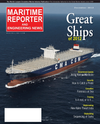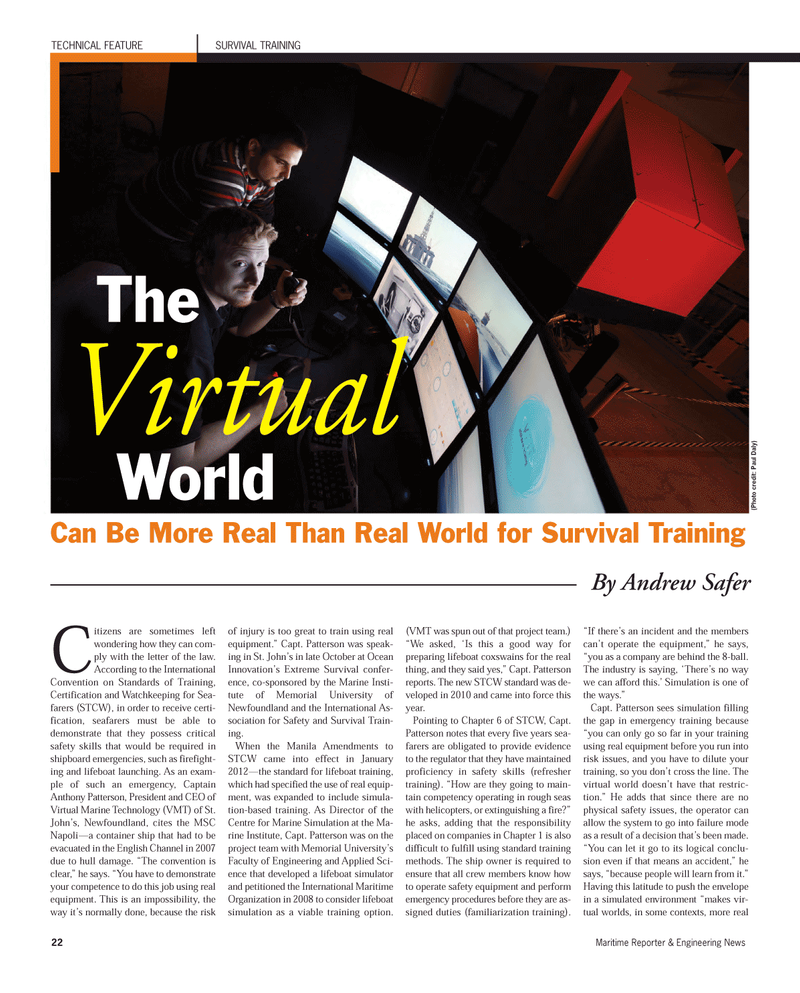
Page 22: of Maritime Reporter Magazine (December 2012)
Great Ships of 2012
Read this page in Pdf, Flash or Html5 edition of December 2012 Maritime Reporter Magazine
22Maritime Reporter & Engineering News Citizens are sometimes leftwondering how they can com- ply with the letter of the law. According to the InternationalConvention on Standards of Training, Certification and Watchkeeping for Sea- farers (STCW), in order to receive certi- fication, seafarers must be able to demonstrate that they possess critical safety skills that would be required in shipboard emergencies, such as firefight- ing and lifeboat launching. As an exam- ple of such an emergency, Captain Anthony Patterson, President and CEO of Virtual Marine Technology (VMT) of St. John?s, Newfoundland, cites the MSC Napoli?a container ship that had to beevacuated in the English Channel in 2007 due to hull damage. ?The convention is clear,? he says. ?You have to demonstrate your competence to do this job using realequipment. This is an impossibility, the way it?s normally done, because the risk of injury is too great to train using realequipment.? Capt. Patterson was speak- ing in St. John?s in late October at Ocean Innovation?s Extreme Survival confer- ence, co-sponsored by the Marine Insti-tute of Memorial University of Newfoundland and the International As- sociation for Safety and Survival Train- ing.When the Manila Amendments to STCW came into effect in January 2012?the standard for lifeboat training,which had specified the use of real equip- ment, was expanded to include simula- tion-based training. As Director of the Centre for Marine Simulation at the Ma-rine Institute, Capt. Patterson was on the project team with Memorial University?s Faculty of Engineering and Applied Sci- ence that developed a lifeboat simulator and petitioned the International MaritimeOrganization in 2008 to consider lifeboat simulation as a viable training option.(VMT was spun out of that project team.) ?We asked, ?Is this a good way for preparing lifeboat coxswains for the real thing, and they said yes,? Capt. Patterson reports. The new STCW standard was de- veloped in 2010 and came into force this year. Pointing to Chapter 6 of STCW, Capt. Patterson notes that every five years sea- farers are obligated to provide evidence to the regulator that they have maintained proficiency in safety skills (refresher training). ?How are they going to main- tain competency operating in rough seas with helicopters, or extinguishing a fire?? he asks, adding that the responsibilityplaced on companies in Chapter 1 is alsodifficult to fulfill using standard training methods. The ship owner is required to ensure that all crew members know how to operate safety equipment and performemergency procedures before they are as- signed duties (familiarization training). ?If there?s an incident and the members can?t operate the equipment,? he says, ?you as a company are behind the 8-ball. The industry is saying, ?There?s no way we can afford this.? Simulation is one of the ways.? Capt. Patterson sees simulation filling the gap in emergency training because ?you can only go so far in your training using real equipment before you run intorisk issues, and you have to dilute your training, so you don?t cross the line. The virtual world doesn?t have that restric- tion.? He adds that since there are no physical safety issues, the operator can allow the system to go into failure mode as a result of a decision that?s been made. ?You can let it go to its logical conclu- sion even if that means an accident,? he says, ?because people will learn from it.? Having this latitude to push the envelope in a simulated environment ?makes vir- tual worlds, in some contexts, more real TECHNICAL FEATURE SURVIVAL TRAINING The World Can Be More Real Than Real World for Survival Training By Andrew Safer Virtual (Photo credit: Paul Daly) MR#12 (18-25):MR Template 12/3/2012 12:01 PM Page 22

 21
21

 23
23
